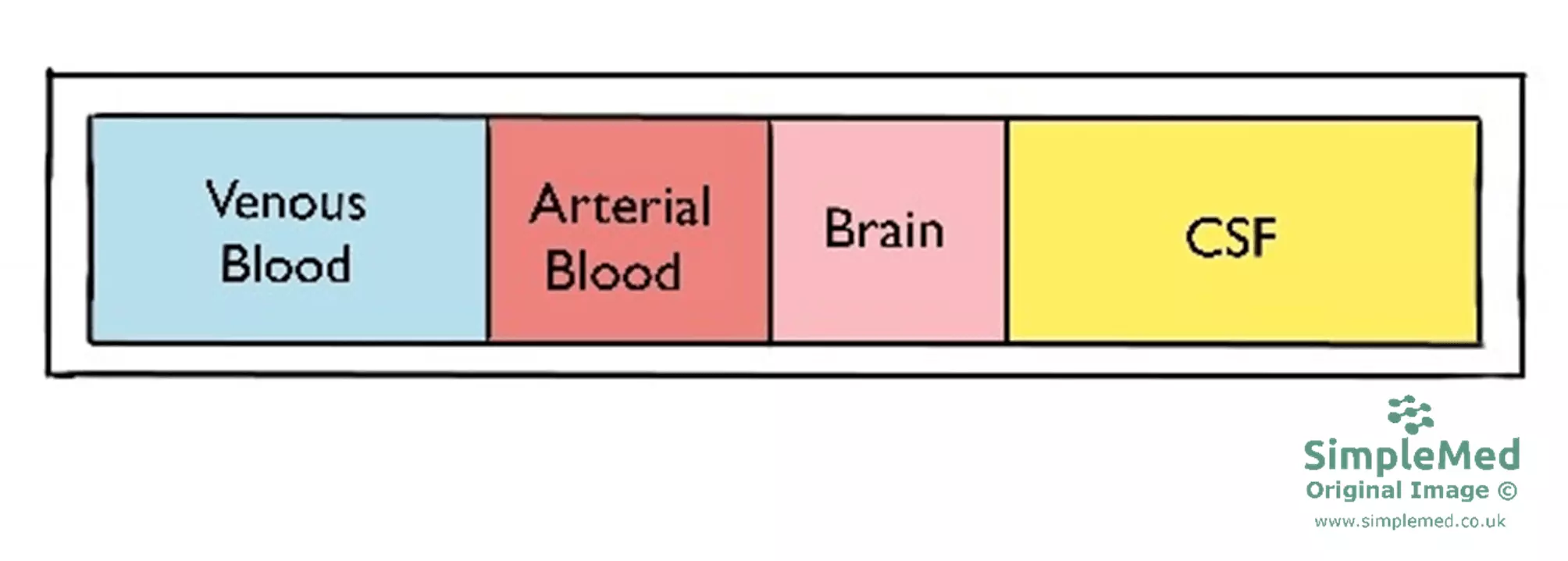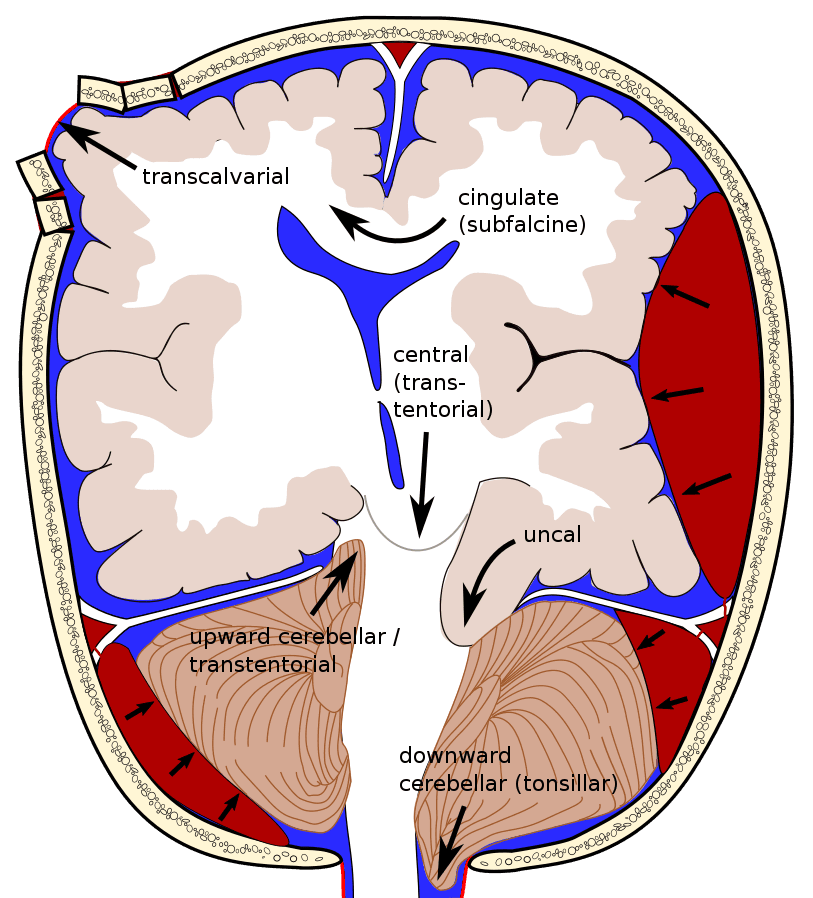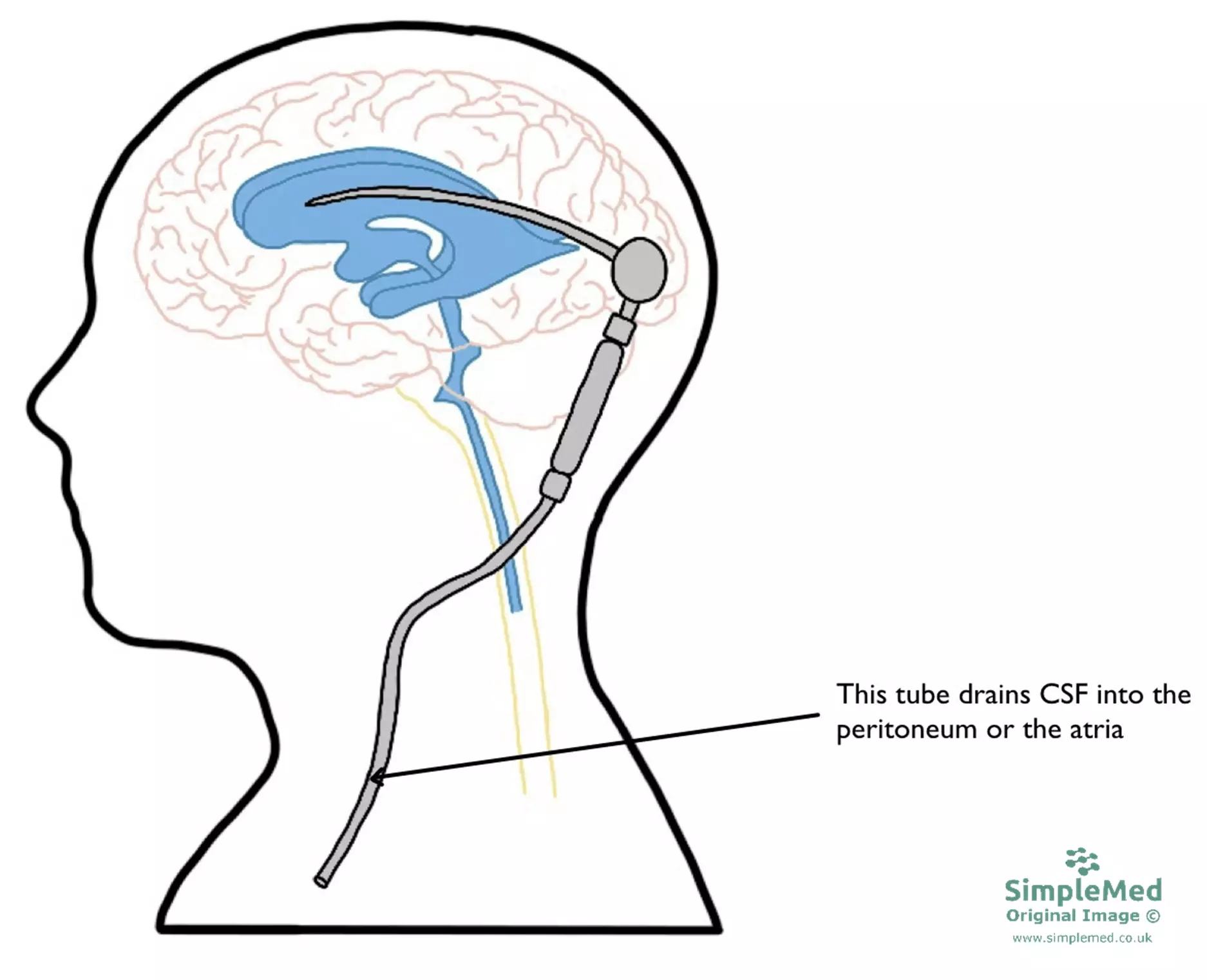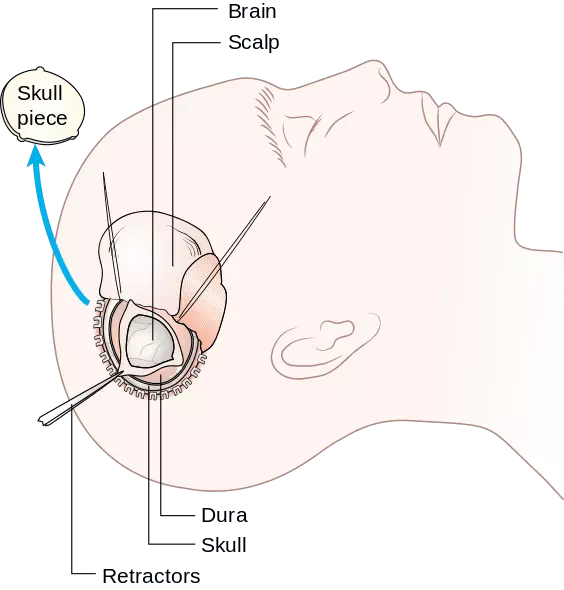Next Lesson - Subarachnoid Haemorrhage
Abstract
- Intracranial pressure (ICP) is the measure of the pressure that the fluids inside the skull exert.
- This can be raised because of an increase in the volume of any of the components in the skull – blood, CSF, brain tissue, or an external factor.
- This can be compensated by initially draining the venous blood or CSF.
- If the compensatory mechanisms are overwhelmed, the patient could present with brain herniation and Cushing’s triad of symptoms.
- Raised ICP is managed by removing the extra pressure on the skull and the brain tissue.
Core
Intracranial pressure (ICP) is the measure of the pressure that fluids inside the skull exert in a closed environment. Things inside the skull that contribute to this pressure are blood (both venous and arterial supplies), cerebrospinal fluid (CSF), and brain tissue.
In adults, this pressure is usually between 5-15 mmHg, whereas it is much lower in children (5-7 mmHg) and infants (1.5-6 mmHg). Raised ICP is defined as pressures within the skull exceed 20 mmHg. This can be caused by an increase in any of the constituents of the cranium: blood in the vasculature, CSF in the ventricles or the brain tissue itself. Along with pathological causes, physiological causes of an increased ICP include performing the Valsalva manoeuvre.
The diagram below shows what elements are found inside the skull, and maintain its pressure.

Diagram - The elements are found in the skull
SimpleMed original by Keertana Anne
An increase in any one of the components shown in the diagram will cause an increase in the pressure inside the skull, as the skull itself cannot stretch. This is why an increase in one element must be compensated by a decrease in the volume of another, in order to maintain equilibrium and preserve a normal ICP. This is illustrated by the Monroe-Kellie doctrine.
The main methods of compensation are draining the venous blood or CSF from the cranium, because they are at the lowest pressure. This compensation can occur up until a certain point, at which the brain becomes decompensated, and the ICP will begin to rise.

Diagram - An increase in any one of the components of the cranium or an introduction of a new compartment causes a decrease in the others
SimpleMed original by Keertana Anne
Once the maximum amount of venous blood and CSF has been drained due to increasing ICP, the next portion to drain is the arterial blood. As the arterial blood is carrying the oxygen to the brain, this is not ideal, and will decrease the cerebral perfusion pressure. The cerebral perfusion pressure is the net pressure gradient that causes arterial blood to flow into the brain. This value determines the blood flow into the brain. If it is too high, there is an increased flow of blood into the brain, and this can cause a raised ICP. Conversely, if the perfusion pressure is too low, the brain is at risk of hypoperfusion and can undergo ischaemic changes.
This value is determined by the equation:
Cerebral perfusion pressure (CPP) = Mean arterial pressure (MAP) – Intracranial pressure (ICP)
The normal values for each of these are:
- CPP: > 70 mmHg
- MAP: 65 – 110 mmHg
- ICP: 5 – 15 mmHg
A rise in the ICP can cause a low CPP, and a rise in the MAP can cause a high CPP. It is important to keep these value within their normal ranges in order to maintain equilibrium.
The Cushing’s Triad is a presentation consisting of systolic hypertension, bradycardia and irregular breathing. These occur in response to the Cushing Reflex, which is an emergency presentation of raised ICP and can indicate imminent brain herniation and death. It is caused by the decrease in cerebral perfusion pressure (as mentioned above) which causes cerebral ischaemia as lactate and other metabolites build up in the brain.
This cerebral ischaemia triggers a sympathetic nervous response in the body which acts on α1-receptors and causes cerebral arterial constriction. This is done in order to try and increase the arterial pressure of the vessels and causes systemic hypertension. The systolic blood pressure increases much more than the diastolic, which results in increased pulse pressure.
The increase in blood pressure is detected by baroreceptors (pressure sensors) in the aortic arch, and these activate the parasympathetic nervous system. This acts on the mechanoreceptors (M2) in the heart and slows the heart rate, leading to bradycardia. The increased parasympathetic response also causes an increase in the production of stomach acid, leading to a higher rate of ulcers being formed – called Cushing’s Ulcers. It is important to remember though that Cushing’s Triad is a very severe thing indicating brain herniation – a lot of the patients with this condition are not around long enough to form stomach ulcers!
Hypertension, along with the raised ICP also has a compressive effect on the brainstem. This is where the respiratory centres are found and damage to these causes irregular breathing, therefore completing the Cushing’s triad. The risk that these three signs pose together accelerates rapidly and can quickly lead to death.
As mentioned earlier in the article, a rise in ICP will initially cause blood and CSF to drain from the cranium, as these are at the lowest pressure. Once these compensatory mechanisms fail, the next step is the compensatory movement of brain tissue in any way that it can. This is called herniation, as it is the movement of an organ out of the region it is normally contained in, similar to an abdominal hernia involving the movement of bowel tissue outside the peritoneal cavity.
If the skull is intact, the brain tissue must herniate across structures such as the falx cerebri, the tentorium cerebelli, and through the foramen magnum. If a skull fracture is present, the brain tissue may herniate out of the fracture site. The herniation of brain tissue can put extreme amounts of pressure on the brain and cut off its blood supply, which can often be fatal.
There are multiple types of brain herniation.

Diagram - The different types of brain herniation
Creative commons source by RupertMillard, modified from Delldot [CC BY-SA 4.0 (https://creativecommons.org/licenses/by-sa/4.0)]
Cerebellar (or tonsillar) herniation, also known as ‘coning’, occurs downwards through the foramen magnum. This can cause compression of the lower brainstem and part of the cervical spinal cord. This type of herniation can result in impaired respiratory and cardiac function, as seen in Cushing’s Triad.
Subfalcine herniation occurs across the midline and is the most common type. The innermost part of the frontal lobe moves across the falx cerebri that separates the two hemispheres of the brain. This is most likely to damage the blood vessels in that area of the brain (including the anterior cerebral artery).
Uncal herniation occurs when an area of the temporal lobe, the uncus, herniates downwards towards the brainstem. This primarily affects the midbrain and can also compress the oculomotor nerve (CN III), resulting in an oculomotor nerve palsy (‘down-and-out’ eye position). This can progress to central herniation.
Central herniation occurs when the diencephalon and areas of the temporal lobes herniate underneath the free edge of the tentorium cerebelli. The diencephalon normally processes sensory information and emotions, and also controls hormone production. This type of herniation can cause paralysis of upward eye movements, resulting in the patient having ‘sun-setting’ eyes.
External (or transcalvarial) herniation occurs through a breach in the cranium, following a traumatic head injury or surgical intervention (such as a craniectomy).
Causes
There are four main causes of increased ICP. Three of these are due to an increase in the original components of the cranium:
An increased volume of blood inside the cerebral vessels can be due to conditions such as malignant hypertension (increased arterial blood – a rapid increase in arterial blood pressure that causes organ damage) or superior vena cava obstruction (increased venous blood – this is caused by external compression of the superior vena cava that drains venous blood from the cranium).
This is caused by a condition called hydrocephalus, which causes an accumulation of CSF surrounding the brain. Hydrocephalus can either be congenital (which is more common) or acquired.
Congenital causes can include a deformity to the structure of the brain: such as neural tube defects or stenosis of the cerebral aqueduct between the third and fourth ventricles. Children present with bulging fontanelles (the ‘soft spot’ of the head) and sun-setting eyes. It can be managed acutely by drainage of CSF through the fontanelle, and long-term management includes the placement of a ventricular shunt. These shunts continuously drain CSF from the ventricular system in the brain to either the peritoneal cavity (V-P shunt) or the atrium (V-A shunt). Some shunts drain CSF directly to the external environment, called external ventricular drains (EVD).

Diagram - Where ventricular shunts are inserted to drain CSF from the brain
SimpleMed original by Keertana Anne
An increase in the volume of brain tissue inside the cranium is caused primarily by the swelling of the tissue. This is known as cerebral oedema and is the build-up of fluid in the intracellular and extracellular compartments of the brain tissue. Oedema can be caused by a wide range of injuries to the brain tissue, including but not limited to: ischaemic stroke, traumatic brain injury and infection (such as meningitis or encephalitis).
The final cause of raised intracranial pressure comes from abnormal masses in the brain which can be tumours, abscesses or haemorrhages. These cause a ‘mass effect’ in the brain and can cause damage to the components in the cranium.
Idiopathic Intracranial Hypertension
When there isn’t a definable cause for the increase in ICP, the condition is called Idiopathic Intracranial Hypertension (IIH). The pathophysiology is not fully understood, however, it primarily affects obese, middle-aged women. It can be diagnosed with a lumbar puncture with a high opening pressure. Treatment includes a healthy diet, exercise and blood pressure control.
In the early stages of raised ICP, the patient may present with the following signs and symptoms:
- Headache – this is usually worse in the morning (as when lying down there is increased CSF drainage into the cranium) and when bending or coughing (this increases the pressure further). The headache is constantly present.
- Difficulty concentrating or focusing
- Confusion – this may be very subtle.
- Nausea and vomiting
- Double vision – the patient has a poor accommodation reflex, may report worsening eyesight or specific visual field defects, and can develop papilloedema.
- Seizures
- Focal neurological signs – including changes in behaviour and difficulty in moving or talking.
In the later stages when the ICP is too high and compensatory mechanisms fail, brain herniation occurs, along with developing Cushing’s reflex.
In patients that present with the above symptoms, the following investigations would take place:
- A full history – if the patient is also experiencing seizures a collateral history is also important.
- Neurological exam – full cranial and peripheral nerve exam.
- Examination of the eyes – fundoscopy, pupillary reflexes, and visual fields.
- Lumbar puncture – this measures the pressure of the CSF.
- CT scan – this is used to look at cross-sectional images of the brain.
Once the patient has been diagnosed with having a raised ICP, the next steps would be to try and decrease the pressure on the brain tissue.
The initial goal would be to protect the brain tissue. This would be achieved by ensuring the patient is being oxygenated well and provided sufficient fluids to maintain the cerebral perfusion pressure. The patient must also have their head slightly elevated in order to improve the venous drainage from the brain.
Direct treatment of the raised ICP includes giving the patient Mannitol, which acts by increasing the osmotic pressure outside the blood-brain barrier and causes the fluid from brain cells to flow into the plasma. Giving 3% hypertonic saline would also have the same effect.
As a temporary measure, an external ventricular drain could be inserted, connecting the ventricular system to the external environment and draining off excess CSF. This would need to be performed as an inpatient procedure and would temporarily reduce the pressure on the brain.
In some extreme cases where all the above fail, a decompressive craniectomy could be performed. This is a surgical procedure where part of the skull is temporarily removed to allow a swelling brain room to expand without being compressed. To reduce the risk of brain injury, the patient is required to wear a helmet or have a small implant inserted into their skull. Then, once the raised ICP has resolved the opening in the skull is closed again, by a cranioplasty.

Diagram - A decompressive craniectomy
Creative commons source by Cancer Research UK [CC BY-SA 4.0 (https://creativecommons.org/licenses/by-sa/4.0)]
Edited by: Dr. Maddie Swannack
Reviewed by: Dr. Thomas Burnell
- 2728

